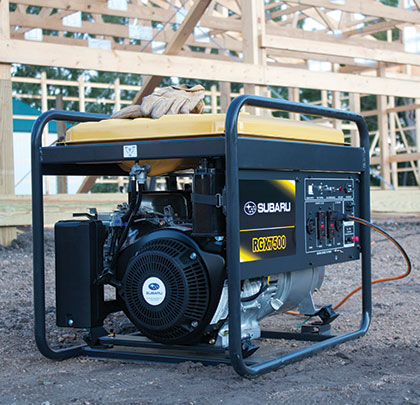Breaking down the differences in portable gas-powered generators.
An important tool on nearly any worksite, generators all provide one important thing—power. It’s important to distinguish how each benefit fits into the three classes: industrial, commercial, and consumer.
PREMIUM PICK
Known as the premium models, industrial generators are virtually always equipped with a fuel-efficient, EPA-compliant, top-of-the-line engine. In addition to delivering reliability and efficiency, a premium engine incorporates high quality components, such as the fuel tank, sound-suppressing mufflers, and heavy-duty air cleaners. Oftentimes, the generator and its engine will be manufactured by the same company, offering the added benefit of providing the customer with one integrated unit and warranty policy covering the whole machine.
Industrial generators, however, offer more benefits than what are found in just the engine. Benefits such as an auto idle control system to conserve fuel, external battery chargers for added convenience, and a full-power switch. Additionally, a professional-grade control panel is found on higher quality, OSHA-compliant, industrial units, and includes safety features such as ground fault circuit interrupter (GFCI) receptacles.
Finally, industrial generators feature high quality construction, including steel frames to protect the unit from damage. And whether standard or optional, industrial generators offer portability-enhancing kits, ensuring easy transport from site to site.
BASIC BUY
Several types of extremely simple generators are available, all falling into the category of light-duty consumer generators. Manufacturers of these units typically assume most end-users purchase one simply to have on hand in case of a blackout, or to provide the occasional backup power boost on a jobsite. In other words, it’s almost expected that consumer generators will rarely be used and, therefore, they aren’t built for the same longevity, sound reduction, and fuel efficiency characteristics of their premium counterparts.
Consumer units will supply power, but because of their simplistic design and construction quality, typically don’t last many hours, nor can most take the abuse of a typical worksite or life in a rental yard. Many skimp on the majors like a good control panel, and overall construction and component quality. And because they’re not looked at as an investment, many consumer generator manufacturers even forgo features that aid in and encourage routine maintenance—most importantly, a warranty program and service network.
This isn’t to say consumer generators don’t have a place in the market; they certainly do. They’re a low-cost option for those on a strict budget. And for others, they may only plan on using the generator once or twice, but prefer to own one so it’s available when needed, rather than take the time to rent one when a need arises.
But because most contractors and rental center operators are looking for even a small return on investment, consumer generators may not offer enough to justify the purchase. But at the same time, many smaller rental centers aren’t able to splurge on an expensive industrial model. To address and fill this gap, some manufacturers provide a high-quality, yet lower-cost alternative to expensive industrial styles. These units give consumers a bit more bang for their buck and potential for quick ROI.
UNCOMPROMISING OPTION
An end-user simply looking for a backup power source is unlikely to require an industrial generator, yet will want something more reliable and long-lasting than a cheap, throw-away unit. Additionally, many contractors, especially smaller ones, may find industrial generators a bit much, both in price and operation complexity. And for rental centers, it’s all about customer needs and ROI. For this large group of customers, commercial generators offer an ideal “middle of the road” option.
In their most general terms, commercial generators are a less expensive generator choice compared to industrial models. They still fulfill the basic requirement—supplying power—however don’t include all the bells and whistles like their industrial counterparts. But the key is, they’re able to trim out features without sacrificing quality, advanced technology, and reliable performance of expensive models.
For starters, a quality engine is key to a high-performance generator. While some consumer generator manufacturers skimp on the engine, commercial units incorporate a high-quality engine. Some also provide a premium-grade warranty that covers the entire unit.
In addition to the engine itself, many commercial generators include quality components like a good muffler to suppress noise and air cleaner to protect the engine. Metal fuel tanks provide excellent durability and the capacity to provide long run time without refueling. And many styles of commercial generators still offer the small, yet valuable add-ins like a fuel tank gauge and strainer.
Automatic Voltage Regulator (AVR) systems are left out of cheap consumer models, but are often found on commercial units, as well as a professional-grade control panel. Commercial generators also often include an hour meter for maintenance tracking and service, as well as a low-oil alert light to signal when the lubrication level drops.
Each generator class provides benefits to specific contractors. However, a high-quality commercial unit can pack a big punch, and provide reliability, durability, and continuous power that contractors demand without blowing up a budget. ■
About The Author:
Pam Meyer is equipment sales manager for Subaru Industrial Power Products. With nearly 30 years experience in power equipment sales, she is an expert on proper pump and generator selection for disaster preparedness and emergency management situations. For more information, contact Meyer at 847.847.2963 or pmeyer@robinamerica.com.
_________________________________________________________________________
Modern Contractor Solutions, February 2013
Did you enjoy this article?
Subscribe to the FREE Digital Edition of Modern Contractor Solutions magazine.

Top-To-Bottom and In-Between: Part 2


